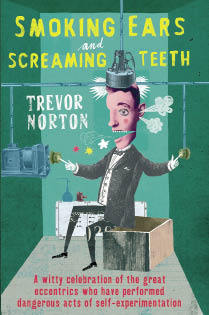When school-children are asked to draw a scientist, says Trevor Nelson, nine out of ten of them draw a mad scientist. My first thought on reading this was: why is there no photograph of Nelson on the dustcover of this book? Might he look particularly bonkers? After seconds of exhaustive research I found a picture of him on the internet, and he looks rather a jolly old soul. Professor of Marine Biology at Liverpool until his retirement, Nelson has since written a couple of quirky memoirs and a not wholly unquirky history of diving. This new book is subtitled ‘A witty celebration of the great eccentrics who have performed dangerous acts of self-experimentation’. He has not come to bury the mad scientist archetype, he has come to praise him.
His research has been intensive and his material is rich and plentiful. He starts with John Hunter, the Scottish farmer’s son who changed surgery from a trade into a science. Hunter became fascinated with venereal diseases, probably because so many of his patients had them. (James Boswell ‘had 19 or more bouts of gonorrhoea without learning his lesson’.) Hunter believed that gonorrhoea and syphilis couldn’t occupy one body at the same time, so must be different phases of the same disease.
On whom could he test this radical (and wholly incorrect) hypothesis? You’ve guessed it. So Hunter cut incisions in his own penis and inserted someone else’s gonorrhoeic discharges into it.
Unfortunately Hunter had also given himself syphilis, and took mercury to cure himself, which made him equally, but differently, ill. This is all in chapter one, by the way. There is much more to come.
Surgeons, of course, needed analgesics for their patients, but there weren’t any. A Japanese surgeon spent 20 years testing different combinations of plant extracts on animals, seeking one that dulled pain without dangerous side effects. In 1804, he thought he had found it, and tried the compound on his wife. She went blind.
Meanwhile, in England, medics were inhaling every gas and combination of gases they could find. The 21-year-old Humphrey Davy tried nitrous oxide, and realised that it nullified the pain from his emerging wisdom teeth. But he also noticed that it made you feel just great, and would be a wow at parties. He swiftly forgot about its analgesic qualities, and no one else thought of using it as a practical painkiller for another 40 years.
These tales are variously heroic, absurd, astounding, revolting and highly entertaining. In the 19th century Frank Buckland, son of the Dean of Winchester, kept a vast menagerie of imported animals, partly to see how good they were to eat. When he heard that a panther had died at the zoo, he asked for samples. They dug it up and sent him some, which tasted horrible. In an abandoned fort on an island in the Gulf of Finland, a Romanov prince set up a laboratory to study plague and develop a vaccine. ‘Two scientists died after being accidentally infected. The incineration of their bodies contributed to the in-house heating.’
Over a period of six years an American radiologist named George Storer deliberately tested the effects of radium on his own body. He later needed several amputations and more than 100 skin grafts. Before his premature death he said, ‘A few dead or crippled scientists do not weigh much against a useful fact.’ Or, as Nelson puts it, ‘Curiosity has killed more than cats.’
This book may not be for the squeamish or the very gentle of disposition: sentences like ‘It was not a pleasant way to die’ crop up frequently. But you soon come to share Nelson’s admiration for these crazed men and women — people like Dr Claude Barlow, an American missionary in China who became fascinated by blood flukes, hideous flatworms that gave rise to schistosomiasis or ‘big belly’, once the second most common disease in the world. Flukes spend some of their lifespan in freshwater snails, and Dr Barlow wanted to know whether American snails would be susceptible. He tried exporting some but they all died in transit. So he infected himself with flukes, flew home, and for 18 months endured horrendous pain, passing 12,000 fluke eggs a day (and unable to sleep because he had to urinate every 20 minutes). The cure, injections with toxic antimony, damaged his heart and he was too weak to carry out his experiment. Instead, a colleague tried to infect American snails with flukes. The experiment didn’t work.






Comments